Related Research Articles
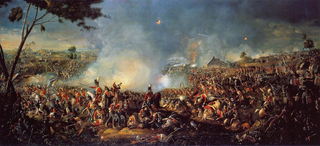
The Battle of Waterloo was fought on Sunday 18 June 1815, near Waterloo. A French army under the command of Napoleon was defeated by two of the armies of the Seventh Coalition. One of these was a British-led coalition consisting of units from the United Kingdom, the Netherlands, Hanover, Brunswick, and Nassau, under the command of the Duke of Wellington. The other was composed of three corps of the Prussian army under the command of Field Marshal von Blücher. The battle marked the end of the Napoleonic Wars. The battle was contemporaneously known as the Battle of Mont Saint-Jean (France) or La Belle Alliance.

The Battle of Ligny, in which French troops of the Armée du Nord under the command of Napoleon I defeated part of a Prussian army under Field Marshal Blücher, was fought on 16 June 1815 near Ligny in what is now Belgium. The result was a tactical victory for the French, but the bulk of the Prussian army survived the battle in good order, was reinforced by Prussian troops who had not fought at Ligny, and played a role two days later at the Battle of Waterloo. The Battle of Ligny was the last victory in Napoleon's military career.

Lasne is a municipality of Wallonia located in the province of Walloon Brabant, Belgium, south east of Brussels.

La Haye Sainte is a walled farmhouse compound at the foot of an escarpment on the Charleroi-Brussels road in Belgium. It has changed very little since it played a crucial part in the Battle of Waterloo on 18 June 1815.

La Belle Alliance is an inn situated a few miles south of Brussels in Belgium, chiefly remembered for its significance in the aftermath of the Battle of Waterloo.
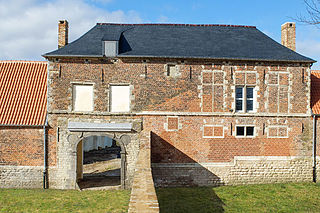
Château d'Hougoumont is a walled manorial compound, situated at the bottom of an escarpment near the Nivelles road in the Braine-l'Alleud municipality, near Waterloo, Belgium. The site served as one of the advanced defensible positions of the Anglo-allied army under the Duke of Wellington, that faced Napoleon's Army at the Battle of Waterloo on 18 June 1815.

The Waterloo campaign was fought between the French Army of the North and two Seventh Coalition armies, an Anglo-allied army and a Prussian army. Initially the French army was commanded by Napoleon Bonaparte, but he left for Paris after the French defeat at the Battle of Waterloo. Command then rested on Marshals Soult and Grouchy, who were in turn replaced by Marshal Davout, who took command at the request of the French Provisional Government. The Anglo-allied army was commanded by the Duke of Wellington and the Prussian army by Prince Blücher.

Sharpe's Waterloo is a historical novel in the Richard Sharpe series by Bernard Cornwell. Originally published in 1990 under the title Waterloo, it is the eleventh novel of the Sharpe series and the twentieth novel in chronological order. Cornwell intended to end the series here, but later changed his mind.

The Lion's Mound is a large conical artificial hill located in Wallonia in the municipality of Braine-l'Alleud, Belgium. King William I of the Netherlands ordered its construction in 1820, and it was completed in 1826. It commemorates the location on the battlefield of Waterloo where a musket ball hit the shoulder of William II of the Netherlands and knocked him from his horse during the battle. It is also a memorial of the Battle of Quatre Bras, which had been fought two days earlier, on 16 June 1815.
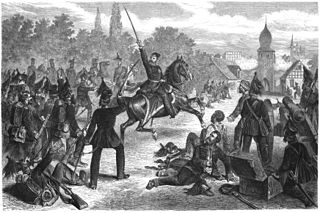
The Brunswick Ducal Field-Corps, commonly known as the Black Brunswickers in English and the Schwarze Schar or Schwarze Legion in German, were a military unit in the Napoleonic Wars. The corps was raised from volunteers by German-born Frederick William, Duke of Brunswick-Wolfenbüttel (1771–1815). The Duke was a harsh opponent of Napoleon Bonaparte's occupation of his native Germany. Formed in 1809 when war broke out between the First French Empire and the Austrian Empire, the corps initially comprised a mixed force, around 2,300 strong, of infantry, cavalry and later supporting artillery.

Saint-Amand is a village of Wallonia and a district of the municipality of Fleurus, located in the Arrondissement of Charleroi, province of Hainaut, Belgium.
The Brigade van Bylandt was a Dutch infantry brigade led by major general Willem Frederik Graaf van Bylandt which fought in the Waterloo Campaign (1815).

After the fighting at Quatre Bras the two opposing commanders Marshal Ney and the Duke of Wellington initially held their ground while they obtained information about what had happened at the larger Battle of Ligny. They received intelligence that the Prussian army under the command of Prince Blücher had been defeated by the French Army of the North under the command of Napoleon Bonaparte.

On 16 June 1815, the French defeated the Prussians at the Battle of Ligny. The Prussians successfully disengaged and withdrew north to Wavre where they regrouped, and later advanced westward with three corps to attack the right flank of the French army at the Battle of Waterloo. The French were slow to exploit Ligny; Napoleon wasted the morning of 17 June with a late breakfast and touring the previous day's battlefield before organising a pursuit of the two Coalition armies. Napoleon and Marshal Michel Ney took the French reserves to pursue the Duke of Wellington's Anglo-allied army. Marshal Emmanuel de Grouchy was ordered to pursue and harry the Prussians and prevent them from regrouping.

Papelotte Farm is located at Rue Du Dimont a rural road in the Municipality of Braine-l'Alleud around 15 km (9.3 mi) south of Brussels, Belgium. On June 18th, 1815 during the pivotal Battle of Waterloo it served as one of the advanced defensible positions of the Anglo-allied army under the command of the Duke of Wellington. Along with the walled farm compounds of Hougoumont and La Haye Sainte, it proved to be instrumental to the delay and the disruption of the opposing Napoleonic army's progress on the battlefield. Napoleon diverted disproportionately large numbers of troops in order to capture or eliminate these perimeters, while he failed to achieve a decisive break through in one of several attacks on the lines of the Allies.
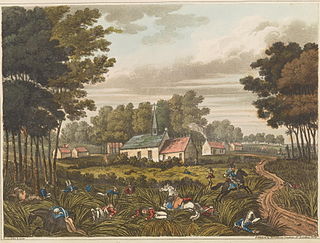
Châteaux Frischermont or Fichermont in the Belgian municipality of Lasne is now a ruin. At the start of the Battle of Waterloo in 1815 it was garrisoned by Dutch soldiers on the easternmost flank of Wellington's defensive line.
Marache, or historically Smohain, is hamlet of Wallonia in the municipalities of Lasne, district of Plancenoit, and Waterloo, in the province of Walloon Brabant, Belgium.

Jean-Baptiste Decoster (1760–1826) was a farmer who became an unwilling guide for Napoleon Bonaparte during the Battle of Waterloo and later became a tourist battle field guide in the years following the battle.
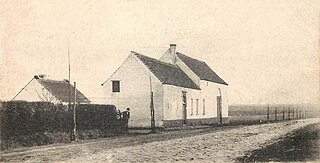
Decoster's house was a landmark location during the Battle of Waterloo. It stood on the eastern side of the Waterloo–Genappe main road south of the junction with the minor road to Plancenoit. According to Jean-Baptiste Decoster Napoleon spent the early part of the Battle of Waterloo and around Rossomme and then at about 17:00 moved to a position near Decoster's house where he remained until about 19:00.
References
- Mason, Antony (2015), Waterloo & Beyond (illustrated ed.), Bradt Travel Guides, p. 49, ISBN 9781784770013
- Summerville, Christopher (2014), Who was Who at Waterloo: A Biography of the Battle, Routledge, p. 418, ISBN 978-1-317-86819-4
- Weller, Jac (2010), Wellington at Waterloo, Frontline Books, p. 134, ISBN 978-1-4738-2064-7
Coordinates: 50°40′50″N4°26′10″E / 50.68043°N 4.43622°E